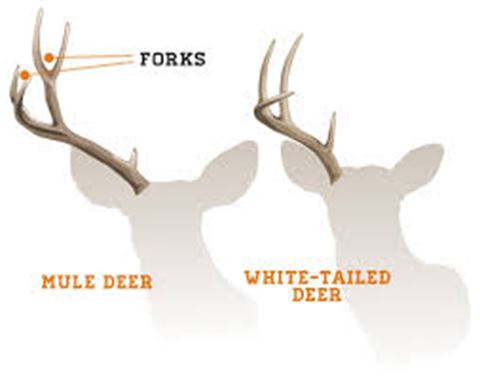If you are new to the great outdoors and or hunting it can sometimes be difficult to distinguish between certain species. Take for example the Whitetail and Mule deer. At face value they have similar characteristics, perhaps the most common similarity is their physical makeup. Both deer are similar in stature standing roughly 3 to 3-1/3 feet off the ground. For a beginner based on height alone it would not be easy to distinguish one between the other. With weight being similar, as well as both males having antlers it doesn’t make it any easier for someone to pinpoint which is which. The Mule and Whitetail deer also have similar brown coats making it even that much more difficult for a new hunter.
If hunting it is absolutely essential that one can distinguish between the Whitetail and Mule deer to ensure a mistake is not made and the wrong species is taken without the proper tag. Now whereas Whitetails can be found in almost all of North America the Mule deer tends to be found in fewer areas and are predominantly spotted in Western North America.

To help identify a Whitetail from a Mule deer there are some key attributes to look for on the animal. These features are the main recognizable differences between the two mammals:
- Facial features
- Antler Shape
- Rear (tail)
- Ear Size
Facial Features
Mule deer have a distinct patch of white from their eyes to their nose that is lighter than the rest of their coat. When looking at a Whitetail’s face you will see that their entire face is similar to the rest of their coat. Around the Whitetail’s nose you will find some white, but not as much as found on the Mule deer. The facial distinction is perhaps one of the easiest and most recognizable tools to use in differentiating the two.

Antler Shape
Though both species have antlers that they shed and regrow each year there are some differences between the two. Mule deer antlers have more of a fork look to them. They have a main beam split that goes in two directions and as they grow they continue to fork. A Whitetail’s antlers do not fork; they have one main beam rather where other tines grow off of the main beam. This is a more difficult observation then the facial features, but can be used to distinguish the two.

Rear End
As the name ensues, the Whitetail’s tail white on the inside; imagine the tail up at alert or if the deer is running away you would see a patch of white. When the tail is down it is a thick brown patch with traces of white on the rear.

When looking at a Mule deer tail you will find that it is thinner and mostly white on the outside with a black tip at the bottom. The rear is also more white then the rear of the Whitetail.


Ear Size
Like the Whitetail is known for their tail, Mule deer are known for their ears. Mule deer have distinct ears, which are large in proportion to their body. The ears are also on more of an angle per say then those of the Whitetail, which are straighter. A Whitetail’s ears also are smaller in proportion to their bodies.


Using these distinctions in the field are quick and helpful in identifying the differences between the Mule and Whitetail deer. Hopefully on your next outing you will be able to put some of these characteristics to the test or share them with a beginner wanting to learn more about the main differences between Mule and Whitetail deer.
Foundry Outdoors is your trusted home for buying archery, camping, fishing, hunting, shooting sports, and outdoor gear online.
We offer cheap ammo and bulk ammo deals on the most popular ammo calibers. We have a variety of deals on Rifle Ammo, Handgun Ammo, Shotgun Ammo & Rimfire Ammo, as well as ammo for target practice, plinking, hunting, or shooting competitions. Our website lists special deals on 9mm Ammo, 10mm Ammo, 45-70 Ammo, 6.5 Creedmoor ammo, 300 Blackout Ammo, 10mm Ammo, 5.56 Ammo, Underwood Ammo, Buffalo Bore Ammo and more special deals on bulk ammo.
We offer a 100% Authenticity Guarantee on all products sold on our website. Please email us if you have questions about any of our product listings.











































